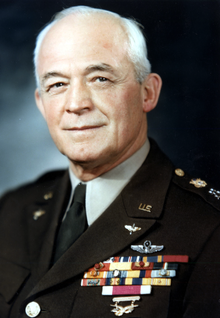Henry H. Arnold | |
|---|---|
 Arnold between 1946 and 1949 | |
| Nickname(s) | "Hap", "Pewt", "Benny", "The Chief" |
| Born | June 25, 1886[1] Gladwyne, Pennsylvania, U.S. |
| Died | January 15, 1950 (aged 63)[1] Sonoma, California, U.S. |
| Buried | |
| Allegiance | United States |
| Service | |
| Years of service | 1907–1947 (Army) 1947–1950 (Air Force) |
| Rank | General of the Army General of the Air Force |
| Service number | O-2255 |
| Commands | United States Army Air Forces Twentieth Air Force 1st Wing, GHQ Air Force |
| Battles / wars | Philippine–American War World War I World War II |
| Awards | Army Distinguished Service Medal (3) Legion of Merit Distinguished Flying Cross Air Medal |
Henry Harley "Hap" Arnold (June 25, 1886 – January 15, 1950) was an American general officer holding the ranks of General of the Army and later, General of the Air Force. Arnold was an aviation pioneer, Chief of the Air Corps (1938–1941), commanding general of the United States Army Air Forces, the only United States Air Force general to hold five-star rank, and the only officer to hold a five-star rank in two different U.S. military services.[2] Arnold was also the founder of Project RAND, which evolved into one of the world's largest non-profit global policy think tanks, the RAND Corporation, and was one of the founders of Pan American World Airways.
Instructed in flying by the Wright Brothers, Arnold was one of the first military pilots worldwide, and one of the first three rated pilots in the history of the United States Air Force.[nb 1] He overcame a fear of flying that resulted from his experiences with early flight, supervised the expansion of the Air Service during World War I, and became a protégé of then Brigadier General (later Colonel) Billy Mitchell.
Arnold rose to command the Army Air Forces immediately prior to the American entry into World War II and directed its hundred-fold expansion from an organization of little more than 20,000 men and 800 first-line combat aircraft into the largest and most powerful air force in the world. An advocate of technological research and development, his tenure saw the development of the intercontinental bomber, the jet fighter, the extensive use of radar, global airlift and atomic warfare as mainstays of modern air power.
Arnold's most widely used nickname, "Hap", was short for "Happy", attributed variously to work associates when he moonlighted as a silent film stunt pilot in October 1911,[3][4] or to his wife, who began using the nickname in her correspondence in 1931 following the death of Arnold's mother. His family called him Harley during his youth, and his mother and wife called him "Sunny".[5] His West Point classmates called Arnold "Pewt" or "Benny" and his immediate subordinates and headquarters staff referred to him as "The Chief".[6]
- ^ a b "Historical Data on Air Force Generals, 1918 to 1951". Air Force Historical Research Agency. March 1951. p. 737.
- ^ Cite error: The named reference
answas invoked but never defined (see the help page). - ^ Huston 2002, p. 5
- ^ Hennessy 1958, p. 54
- ^ Daso 2013.
- ^ Daso 1996: see note 1 for a detailed discussion of the chronology and sources of Arnold's nicknames.
Cite error: There are <ref group=nb> tags on this page, but the references will not show without a {{reflist|group=nb}} template (see the help page).